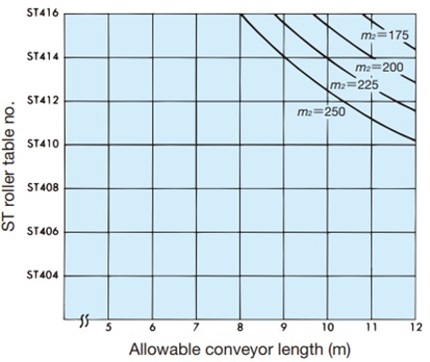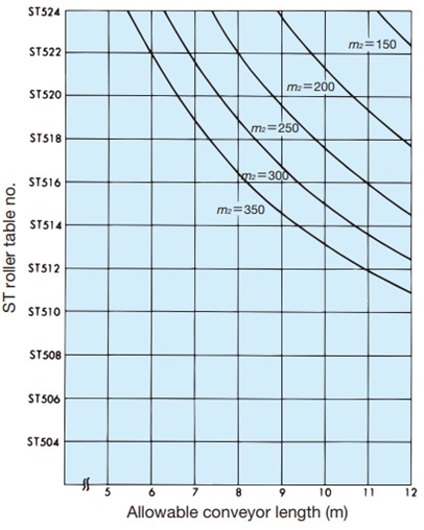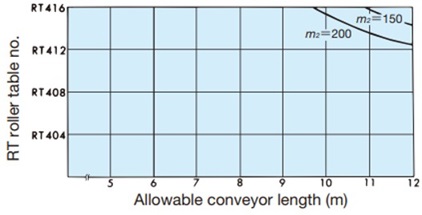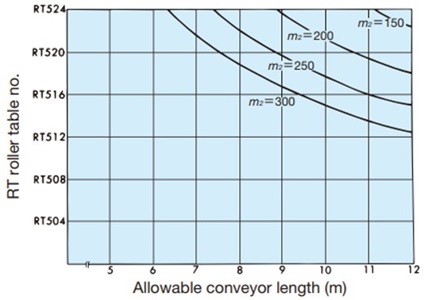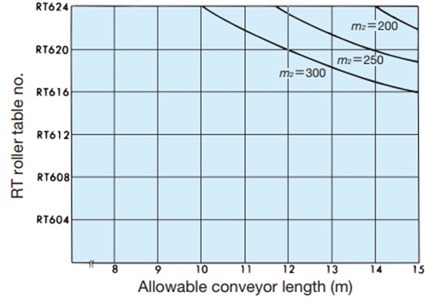Technical Data Top chain Selection
To view selection procedures and precautions, please proceed to the following.
Click here to narrow down the product series or to make a tentative selection.
If you have specific conditions of use and wish to make a detailed selection, please click here.
Selection Process for Plastic Roller Table
Follow the procedure below to select the most appropriate plastic roller table and the wearstrip according to specific operating conditions.
- 1. Check Conveyance Conditions
- 2. Select Chain Model
- 3. Select Chain Size
- 4. Calculating Required Power
Steps 1. Check Conveyance Conditions
Check the operating condition as follows.
Conveyance Conditions Checklist
| 1.Conveyed object | (1)Material |
|---|---|
| (2)Mass per unit g/each | |
| (3)Dimension (length × width) mm | |
| 2.Conveyor layout | (1)Layout of conveyance |
| (2)Conveyor length m | |
| (3)Space m | |
| 3.Conveying conditions | (1)Conveyed Amount /min |
| (2)Interval of conveyed products mm | |
| (3)Conveying speed m/min | |
| 4.Operating environments | (1)Temperature ℃ |
| (2)Conditions which may cause corrosion such as, contact with chemicals, water, and humidity (Corrosion resistance to various fluids) (If “yes”, name of liquid) |
2-(4) Conveyance layout and others
Steps 2. Select Chain Model
ST ...Used when the products are transversely loaded or unloaded.
RT ...Used when the products are not transversely loaded or unloaded (straight loading/unloading). (However, large-size products such as pallets may be transversely loaded or unloaded. )
Steps 3. Determine Chain Size
The size of the chain should be decided using table 1: Selection of Chain Size in Relation to Size of Products and table 2: Conveyor Capacity of ST Roller Tables and RT Roller Tables.
Note) Refer to the section of wearstrip for the wearstrip.
Table 1: Selection of Chain Size in Relation to Size of Products
| Chain size | Dimensions of Conveyed Items (mm) |
|---|---|
| 300 Series | 30 or longer |
| 400 Series | 44 or longer |
| 500 Series | 55 or longer |
| 600 Series | 66 or longer |
Note) The “Dimension of products” is the bottom dimension. Since the dimension of products depends on a balance between the dimension of the bottom and the dimension of the height, the above values are for reference only.
Table 2. Conveyor Capacity of ST Roller Tables and RT Roller Tables
| How to read the table :ST | How to read the table :RT | ||||||||
|---|---|---|---|---|---|---|---|---|---|
|
m2 = 300kg/m2 If overall length is 10 meter, plastic roller tables ST504 to ST514 can be used. m2 = Conveying load (kg/m2) = Weight of conveyed goods (kg) Area of bottom (m2) ST300
ST400
ST500
|
m2 = 300kg/m2 If overall length is 10 meter, plastic roller tables ST504 to ST514 can be used. m2 = Conveying load (kg/m2) = Weight of conveyed goods (kg) Area of bottom (m2) RT300
RT400
RT500
RT600
|
・How to calculate conveying load m2(kg/m2) of round objects
m2 = Conveying load (kg/m2) = Weight of conveyed goods (kg) Area of bottom (m2)
m2 = ω × 106 D2sin60° (kg/m2)
- m2:Conveying load (kg/m2)
- ω:Unit mass of single conveyed products (kg)
- D:Outside diameter (OD) of conveyed products (mm)
Example) For 350 ml can of 66 mm OD and unit mass of 0.37 kg/can
m2 = 0.37 × 106 662 × sin60° = 98kg/m2

Steps 4. Calculating Required Power
The power required is calculated using the following formula.
kW = X・(m1 + m2・H)・S・v 5565・η
- kW = Power required
- m1 = Chain mass (kg/m)
- m2 = Conveying load (kg/m2)
- H = Conveyor width (effective width) (m)
- S = Distance between shafts (m)
v = Chain speed (m/min)
ηNote) = Transmission efficiency of drive unit
X = Coefficient of lubrication (different from coefficient of friction)
- ・When base chain is lubricated X = 0.3
- ・When base chain is not lubricated X = 0.4
Note) For the mechanical transmission efficiency, check the drive unit used.
